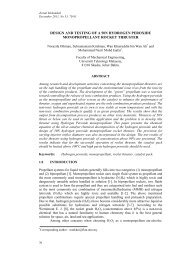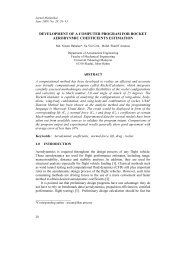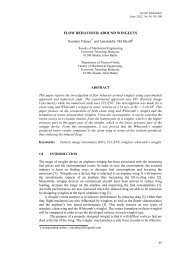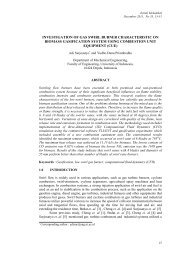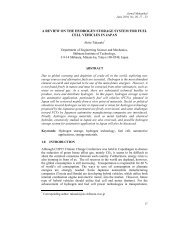effect of accelerometer mass on thin plate vibration - Jurnal Mekanikal
effect of accelerometer mass on thin plate vibration - Jurnal Mekanikal
effect of accelerometer mass on thin plate vibration - Jurnal Mekanikal
You also want an ePaper? Increase the reach of your titles
YUMPU automatically turns print PDFs into web optimized ePapers that Google loves.
<strong>Jurnal</strong> <strong>Mekanikal</strong>, December 2009<br />
3.2 Finite Element Analysis<br />
ABAQUS Versi<strong>on</strong> 6.6.3 was used to obtain the natural frequency and its<br />
corresp<strong>on</strong>ding mode shape <str<strong>on</strong>g>of</str<strong>on</strong>g> the test structure. The test structure was modeled<br />
using shell element and while the <str<strong>on</strong>g>accelerometer</str<strong>on</strong>g> was modeled as hexag<strong>on</strong> solid<br />
element.. The model <str<strong>on</strong>g>of</str<strong>on</strong>g> <str<strong>on</strong>g>accelerometer</str<strong>on</strong>g> was attached <strong>on</strong> the test structure model at<br />
the locati<strong>on</strong>s as shown in Figure 1. The properties <str<strong>on</strong>g>of</str<strong>on</strong>g> the test structure are defined<br />
as follow;<br />
Young’s Modulus, E = 72 x 10 9 Pa<br />
Poiss<strong>on</strong> Ratio, v = 0.3<br />
Density, ρ = 2700 kg/m 3<br />
P2<br />
P1<br />
P3<br />
Figure 1 : Layout <str<strong>on</strong>g>of</str<strong>on</strong>g> <str<strong>on</strong>g>accelerometer</str<strong>on</strong>g> locati<strong>on</strong> <strong>on</strong> the <strong>plate</strong><br />
3.3 Experimental Modal Analysis<br />
The <str<strong>on</strong>g>accelerometer</str<strong>on</strong>g> used for the experimental modal analysis is PiezoBeam<br />
<str<strong>on</strong>g>accelerometer</str<strong>on</strong>g> from KISTLER type 8636C50. It was chosen because <str<strong>on</strong>g>of</str<strong>on</strong>g> its small<br />
size and lightweight with a <str<strong>on</strong>g>mass</str<strong>on</strong>g> <str<strong>on</strong>g>of</str<strong>on</strong>g> 5.84 gram, thus the <str<strong>on</strong>g>effect</str<strong>on</strong>g> <str<strong>on</strong>g>of</str<strong>on</strong>g> <str<strong>on</strong>g>mass</str<strong>on</strong>g> loading is<br />
small and representing 1.3% <str<strong>on</strong>g>of</str<strong>on</strong>g> <strong>plate</strong> <str<strong>on</strong>g>mass</str<strong>on</strong>g>. An impact hammer method <str<strong>on</strong>g>of</str<strong>on</strong>g><br />
excitati<strong>on</strong> was used with KISTLER model 9722A500 impact hammer. It is<br />
equipped with low impedance force sensor to measure the force excited <strong>on</strong> the test<br />
structures. Plastic hammer tip was used to produce signal <str<strong>on</strong>g>of</str<strong>on</strong>g> the force pulse and to<br />
provide a broadband excitati<strong>on</strong> to the interest frequency range <str<strong>on</strong>g>of</str<strong>on</strong>g> 0 – 2000 Hz.<br />
PAK MULLER-MK11 was used as the FFT analyzer to simultaneously measures<br />
the force and resp<strong>on</strong>se, c<strong>on</strong>verted them into digital signals and computed their<br />
Discrete Fourier Transform. ME’scopeVES versi<strong>on</strong> 4.0 was used as modal<br />
analysis s<str<strong>on</strong>g>of</str<strong>on</strong>g>tware to extract the natural frequencies and corresp<strong>on</strong>ding mode<br />
shapes from the measured data.<br />
4.0 RESULTS OF THE NATURAL FREQUENCY<br />
Tables 2 to 7 present the results obtained from numerical and experimental<br />
analysis for the first sixth natural frequency for tested <strong>plate</strong>.<br />
103



